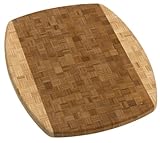There’s more to food than recipes. We’ll approach the answers to growing questions, and new ways of taking on tricks of the food trade, and Boil It Down for you.
For the past couple of years, we’ve been using a bamboo cutting board as our main chopping surface in the kitchen. It made a whole lot of sense at the time. Bamboo’s a green wood and replenishes itself quickly and abundantly; we’re not contributing to the deforestation of some ancient woodlands to prepare our meals.
So far the bamboo cutting boards have served their purpose well. However, I’ve noted that our knives seem to get dull more frequently than they had years ago. Are the knives getting old? Are we just cooking more? Is the bamboo bad for the knives?
We could have gone with plastic cutting boards, but it’s been reported that bacteria finds it a lot easier to hide in crevasses in plastic than with wood boards. Sounds crazy, I know. We have one plastic board that we’ve declared as the fruit-only surface, so we’re not getting some weird onion flavor in our sliced pineapple.
First thing to know about wooden cutting boards is that there are typically two types: edge-grain and end-grain.
Edge-grain — or flat-grain — is the most common wooden cutting board you’ll see in a typical household kitchen. This is the kind of bamboo cutting board we use. It’s easy to tell it’s a flat-grain board because it looks like a bunch of flat pieces of wood, stuck together edge-to-edge. They’re relatively inexpensive, as they’re easier to manufacture.
 End-grain cutting boards are what you’ll often see on a big butcher block. The wood is arranged in a checkerboard pattern rather than the edge or long end of the wood. End-grain boards are more expensive because they’re more durable, cost more to make and look damn nice on your kitchen counter.
End-grain cutting boards are what you’ll often see on a big butcher block. The wood is arranged in a checkerboard pattern rather than the edge or long end of the wood. End-grain boards are more expensive because they’re more durable, cost more to make and look damn nice on your kitchen counter.
So, why are end-grain boards better than edge-grain, besides in looks and durability? Think of how a tree’s fibers run. A long board of wood is cut to the length of the tree, not through its width. The fibers of the tree run vertically, and thus vertically within the long piece of wood. It’s much easier to take an ax and chop the length of a log of wood rather than across it, since you’re splitting down through the fibers of the tree.
In an edge-grain board, your knife is cutting down at the wood grain as though you’re trying to chop down a tree. With end-grain, you’re coming down through the wood fibers as though splitting with an ax (though, of course, without the splitting). End-grain’s easier on your knives because of this, and because you’re not actually cutting the wood and are instead splitting the fibers, the board lasts longer.
Is that the answer then, that the grain of the wood is affecting the knives’ sharpness? Not so fast! There are other things to consider. There’s the type of wood and the resin used to adhere the pieces together, for example. Teak contains silica, which can be very hard on knife edges (though it looks really nice). Some exotic woods contain oils that can come out onto your food and potentially cause allergic reactions (walnut, for example). But what of bamboo, specifically?
Bamboo is a durable and plentiful resource, though is considered by some to be a hard wood (it is, in fact, a kind of grass!) Yes, it’s going to be harder on knife edges, though it’s not the wood to blame as much as it is the way you’re cutting the grain. An edge-grain, hardwood (or grass) board is going to work out your knives faster than any end-grain board.
Basic rule of thumb: stick with end-grain boards if you can afford it. If you must go edge-grain, stick with softer woods if you don’t want your knives going dull on you quicker.